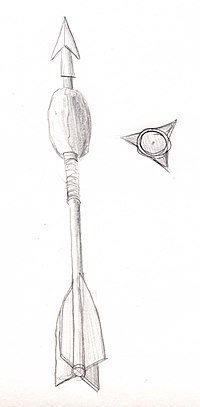Plumbata
| Plumbata | |
|---|---|
 Plumbata with cross section of the tip next to it. |
|
| Information | |
| Weapon type: | spear |
| Use: | Weapon of war |
| Creation time: | about 250 AD |
| Working time: | around 250 AD - 600 AD |
| Region of origin / author: |
Northern Italy, Samnites |
| Distribution: | Roman Empire |
| Overall length: | about 50 to 70 cm |
| Blade length: | about 10 to 12 cm |
| Handle: | Wood, iron, lead, leather |
| Particularities: | In the middle a lead weight, which increases the penetration power and stabilizes the trajectory |
| Lists on the subject | |
The Plumbata ( Plumbatae ) (from Latin plumbum for lead ) or Mattiobarboli was a light, short throwing spear that was used in the Roman legion in ancient times .
Description and use
The name of this weapon is handed down in the late antique military manual Epitoma Rei Militaris by Vegetius Renatus. The unknown author of the font " De Rebus Bellicis " even provides an illustration - although it was made according to medieval ideas. The type 1 plumbata resembled a large dart and consisted of a wooden shaft on which a three-edged iron point with barbs was attached. Type 2 had a square, bolt-like tip, type 3 a lenticular tip and type 4 a three-wing tip (classification according to Theodor Völling). A heavy lead weight was attached to the center of the spear to increase penetration and keep the trajectory straight. At the rear end of the spear, three to four wooden or leather wings were attached to stabilize the flight path.
Similar to the verutum , the plumbata was also used by lightly armed javelin throwers. These little spears could easily be carried on a belt per man or in a shield by five, and so many of them could be taken on the battlefield. As a weapon it was mainly used by the Ferentarii . The plumbata was a particularly effective weapon against riders, as its horses offered a large target area.
history
Early variations of the Plumbata were already in use in the armies of the Greek city-states around 500 BC. In common use. She came into the Roman Legion through the Punic Wars . In late antiquity they became more and more important because of the increased number of riders. It was also used in the migration of Germanic tribes and persisted in variations until the Middle Ages . Especially in the Eastern Roman Empire, which was later called the Byzantine Empire , the plumbata was used until the late Middle Ages .
There are finds of Plumbatae both in the Balkans and in today's Germany in Haltern from the 3rd century AD. The metal tip of this find is 11.8 cm long. A total of 70 copies are known. About half of them are type 1.
literature
- Archaeological scoreboard. from University of Michigan. W. de Gruyter, 1991.
- Alwin Schultz: Court life at the time of the Minnesingers. Volume 2, Verlag O. Zeller, 1965.
- John Warry: Warfare in the Classical World: War and the Ancient Civilizations of Greece and Rome. Salamander Books, 1996, ISBN 0-86101-859-1 , p. 113.
- Anton Höck: The late Roman fortification Teriola am Martinsbühel (MG Zirl): Emergency excavations on the south terrace 1997. In: Fritz Blakolmer, Hubert D. Szemethy (Ed.): Files of the 8th Austrian Archaeological Day at the Institute for Classical Archeology of the University of Vienna from 23 April to April 25, 1999. (Vienna Research on Archeology, Volume 4). Phoibos publishing house, Vienna 2001, ISBN 3-901232-28-1 , pp. 165-176.
